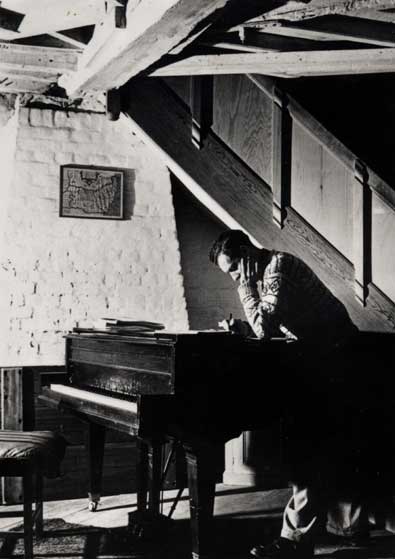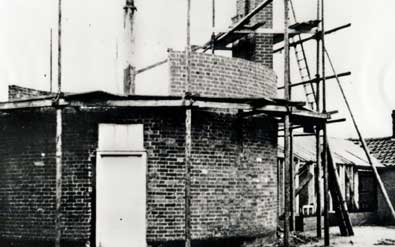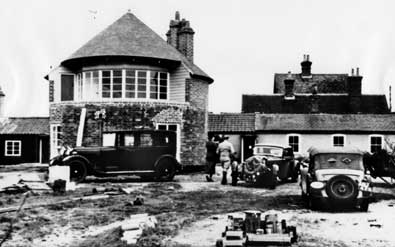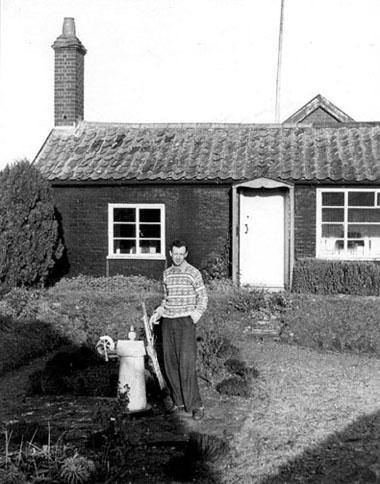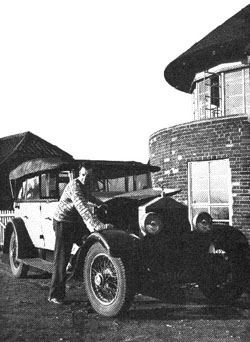
![]()
|
|
The
Britten years
The Windmill ceased working around 1933 and was purchased by Benjamin Britten in September 1937 for the grand sum of £450 using a £2000 legacy from his Mother who had died earlier in the year. The sails, buck and working gear had already been removed and the three foot six inch diameter runner (upper revolving stone) was taken to Saxtead Green Mill to replace the four foot four inch diameter stone there in order to lighten the load. Luckily Britten's sister's future Father-in-Law was an Architect, Arthur Welford who lived at nearby Peasenhall Hall and he offered to design the conversion free of charge to assist the young composer. The main requirement was for a large working studio which was accommodated on the ground floor of the existing roundhouse. With the prominent position on the hill and magnificent southerly aspect over the village, the tidal river and the working maltings, the roof was raised to provide a bedroom with a recessed balcony and window traversing one third of the circumference to take advantage of the view. The existing single storey cottage formed a kitchen, living room and two further bedrooms whilst the adjoining granary was converted into another studio for Britten's fellow composer Lennox Berkeley (1903-1989). The two had become firm friends since meeting in Barcelona in 1936. The rent from Berkeley assisted with the finances. The roundhouse and cottages were linked by a timber framed single storey extension housing a boiler room, fuel store, bathroom and shower room. Although
open fires were constructed in the principal rooms, the Architect
advised central heating also be installed throughout and the original
cast iron radiators have been refitted in the recent refurbishment.
Britten was certainly ahead of his time in having a shower installed
in 1937 in England. Works were complete at the end of April 1938
and the composer moved in to "this quaint old village"
as he described Snape in a letter to a friend. Once ensconced in his new home Britten entertained many of his artistic friends including Peter Pears, Wystan Auden and the American composer Aaron Copland who describes his visit in the book "Tribute to Benjamin Britten on his Fiftieth Birthday" published by Faber in 1963. Britten's sister Beth had married Kit Welford, a medical student in January 1938 and they also made their home at The Old Mill when not in London. In May 1939 Britten and Peter Pears followed the example of W H Auden and left England for America where he continued composing, spending most of his time in Amityville. The Norwich Union insurance policy for the Old Mill and contents dated 1940 is endorsed "The Insured is at present residing in the United States of America". In late 1941 the decision was made to return to England but, being wartime, a passage across the Atlantic could not be obtained until March 1942 in a small Swedish cargo ship. Britten used the month long crossing to compose "Hymn to St Cecilia" and "A Ceremony of Carols" (the current CD cover of the latter shows Britten on the balcony at The Old Mill). Once returned to England Britten was accepted as a conscientious objector and appeared at wartime concerts as a pianist all over Britain and continued composing. He had been considering basing an opera on George Crabbe's poem "The Borough" but the complexity of the composition would rule out any other work and therefore income for a considerable length of time. The conductor Serge Koussevitzky was sufficiently interested in the project to donate $1000 from his Music Foundation for the opera. Thus "Peter Grimes" was begun in January 1944, completed in February 1945 and was first performed on 7th June 1945 in the newly re-opened Sadler's Wells Theatre with Peter Pears in the lead role. Other important
works composed during Britten's time at The Old Mill include: In 1947 Britten moved from The Old Mill Snape to Crag House Crabbe Street Aldeburgh from where he, with other friends, established the Aldeburgh Festival in 1948. He continued to own The Old Mill, letting to tenants until 1955 when it was sold to Mr and Mrs Philip Terry as a holiday home. During his residence at The Old Mill Britten's success was demonstrated by his transport, the second hand Morris Eight that he and friends used to trundle around the Suffolk countryside when he first moved in had been exchanged for a Rolls Royce (left). During the latter part of it's working life the mill had been known as Hudson's Mill after Harry Hudson who purchased in 1897. By coincidence Britten's housekeeper at the Red House in Aldeburgh was a Miss Hudson who was Harry Hudson's niece. Twenty years after his departure from The Old Mill Britten saw the opening of the new concert hall home for the Aldeburgh Festival in the maltings complex that he used to look out on from his bedroom. As with his former home, changing economic and commercial circumstances had forced the maltings to cease operating, but the lovely old building had been found a new use, in this case as a world famous musical venue. Bibliography See
other history files |
